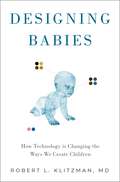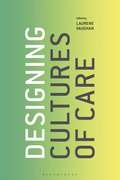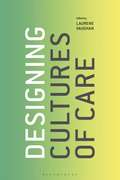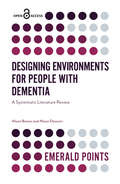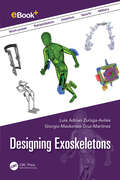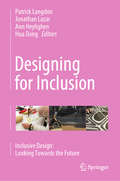- Table View
- List View
Designing and Conducting Research in Health and Human Performance
by Tracey D. Matthews Kimberly T. KostelisDesigning and Conducting Research in Health and Human Performance shows students how to become effective producers and consumers of health and human performance research. The book provides comprehensive coverage of both quantitative and qualitative research methods and includes step-by-step guidance for writing effective research proposals and theses. In addition, the authors show how to read, assess, interpret, and apply published research and how to conduct basic studies in health, physical education, exercise science, athletic training, and recreation. Designing and Conducting Research in Health and Human Performance is filled with illustrative examples that emphasize the real-world applications of research methods. Throughout, the authors draw on a variety of examples that were selected because they provide a context to further the understanding of health and human performance research. Research to Practice examples and Tips are included by the authors to help students better appreciate the book's content. These study aids provide suggestions and additional resources to assist students in understanding the research process. Key Terms, defined and highlighted, enrich each chapter. Chapter Review Questions, designed to help students comprehend and follow best practices in research methods, close each chapter. Online resources and guides developed by the authors to support and enhance students' learning of important research concepts are available.
Designing and Delivering Dementia Services
by Hugo De Waal Constantine Lyketsos David Ames John O'BrienDementia is increasingly and widely recognised as a serious health and social challenge, in the developed world as well as in the developing world. The need therefore to design and implement dementia care services of high quality is becoming more and more vital, particularly given the likelihood of ever increasing demand in a world, which likely sees resources at best remaining at current levels. Designing and Delivering Dementia Services describes current developments in the design and configuration of dementia services. It offers an informative and detailed overview of what constitutes high quality care, considering the circumstances patients and carers may find themselves in. For dementia to get the priority it deserves, a number of factors are important and the book charts the invaluable contributions of various Alzheimer's Associations and Societies: this provides a focus on dementia strategies and plans at national levels: the book reports on the state of affairs regarding such strategies and provides a unique insight into the process of how one of these was developed and implemented. Recognising the need to prove that service developments lead to a higher quality of care, increased productivity and increased efficiency, the book links the resulting picture to service-based research methodologies, with an emphasis on the strengths and limitations of that research. Contributions from 17 countries on 4 continents give an overview of the state of affairs across the world, paying attention to successful - and less successful - initiatives to improve dementia care. The book furthermore provides pragmatic approaches to ensure planning becomes reality, highlights the need for structured workforce development, education and training and describes the opportunities afforded by assistive technology. This book is of prime informative and practical value given that pressures on dementia services are projected to mount across the world against a backdrop of limited resources and expertise. Designing and Delivering Dementia Services Defines the problems involved in meeting an increasing demand for dementia care services in a poorer world Maps initiatives and developments in the design and configuration of these services in a variety of international settings Analyses these developments against the background of political and health economic circumstances Provides a road map of where health services should go in response to this growing challenge. The first book to define, analyse and map initiatives for dementia care services in a time of increasing demand and decreasing resources, this book is essential reading for commissioners, senior clinicians and service planners in health and social care. It will also be of interest to academic researchers involved in qualitative services research as well as quantitative health economic research, health and social care managers and those involved in workforce planning and development.
Designing and Delivering Dementia Services
by Hugo De Waal Constantine Lyketsos David Ames John O'BrienDementia is increasingly and widely recognised as a serious health and social challenge, in the developed world as well as in the developing world. The need therefore to design and implement dementia care services of high quality is becoming more and more vital, particularly given the likelihood of ever increasing demand in a world, which likely sees resources at best remaining at current levels. Designing and Delivering Dementia Services describes current developments in the design and configuration of dementia services. It offers an informative and detailed overview of what constitutes high quality care, considering the circumstances patients and carers may find themselves in. For dementia to get the priority it deserves, a number of factors are important and the book charts the invaluable contributions of various Alzheimer's Associations and Societies: this provides a focus on dementia strategies and plans at national levels: the book reports on the state of affairs regarding such strategies and provides a unique insight into the process of how one of these was developed and implemented. Recognising the need to prove that service developments lead to a higher quality of care, increased productivity and increased efficiency, the book links the resulting picture to service-based research methodologies, with an emphasis on the strengths and limitations of that research. Contributions from 17 countries on 4 continents give an overview of the state of affairs across the world, paying attention to successful - and less successful - initiatives to improve dementia care. The book furthermore provides pragmatic approaches to ensure planning becomes reality, highlights the need for structured workforce development, education and training and describes the opportunities afforded by assistive technology. This book is of prime informative and practical value given that pressures on dementia services are projected to mount across the world against a backdrop of limited resources and expertise. Designing and Delivering Dementia Services Defines the problems involved in meeting an increasing demand for dementia care services in a poorer world Maps initiatives and developments in the design and configuration of these services in a variety of international settings Analyses these developments against the background of political and health economic circumstances Provides a road map of where health services should go in response to this growing challenge. The first book to define, analyse and map initiatives for dementia care services in a time of increasing demand and decreasing resources, this book is essential reading for commissioners, senior clinicians and service planners in health and social care. It will also be of interest to academic researchers involved in qualitative services research as well as quantitative health economic research, health and social care managers and those involved in workforce planning and development.
Designing Babies: How Technology is Changing the Ways We Create Children
by Robert KlitzmanSince the first "test tube baby" was born over 40 years ago, In Vitro Fertilization and other Assisted Reproductive Technologies (ARTs) have advanced in extraordinary ways, producing millions of babies. An estimated 20% of American couples use infertility services to help them conceive, and that number is growing. Such technologies permit thousands of people, including gay and lesbian couples and single parents, to have offspring. Couples can now transmit or avoid passing on certain genes to their children, including those for chronic disease and, probably sometime soon, height and eye color as well. Prospective parents routinely choose even the sex of their future child and whether or not to have twins. The possibilities of this rapidly developing technology are astounding-especially in the United States, where the procedures are practically unregulated and a large commercial market for buying and selling human eggs is swiftly growing. New gene-editing technology, known as CRISPR, allows for even more direct manipulation of embryos' genes. As these possibilities are increasingly realized, potential parents, doctors, and policy-makers face complex and critical questions about the use-or possible misuse-of ARTs. Designing Babies confronts these questions, examining the ethical, social, and policy concerns surrounding reproductive technology. Based on in-depth interviews with providers and patients, Robert Klitzman explores how individuals and couples are facing quandaries of whether, when, and how to use ARTs. He articulates the full range of these crucial issues, from the economic pressures patients face to the moral and social challenges they encounter as they make decisions which will profoundly shape the life of their offspring. In doing so, he reveals the broader social and biological implications of controlling genetics, ultimately arguing for closer regulation of procedures which affect the lives of generations to come and the future of our species as a whole.
Designing Babies: How Technology is Changing the Ways We Create Children
by Robert KlitzmanSince the first "test tube baby" was born over 40 years ago, In Vitro Fertilization and other Assisted Reproductive Technologies (ARTs) have advanced in extraordinary ways, producing millions of babies. An estimated 20% of American couples use infertility services to help them conceive, and that number is growing. Such technologies permit thousands of people, including gay and lesbian couples and single parents, to have offspring. Couples can now transmit or avoid passing on certain genes to their children, including those for chronic disease and, probably sometime soon, height and eye color as well. Prospective parents routinely choose even the sex of their future child and whether or not to have twins. The possibilities of this rapidly developing technology are astounding-especially in the United States, where the procedures are practically unregulated and a large commercial market for buying and selling human eggs is swiftly growing. New gene-editing technology, known as CRISPR, allows for even more direct manipulation of embryos' genes. As these possibilities are increasingly realized, potential parents, doctors, and policy-makers face complex and critical questions about the use-or possible misuse-of ARTs. Designing Babies confronts these questions, examining the ethical, social, and policy concerns surrounding reproductive technology. Based on in-depth interviews with providers and patients, Robert Klitzman explores how individuals and couples are facing quandaries of whether, when, and how to use ARTs. He articulates the full range of these crucial issues, from the economic pressures patients face to the moral and social challenges they encounter as they make decisions which will profoundly shape the life of their offspring. In doing so, he reveals the broader social and biological implications of controlling genetics, ultimately arguing for closer regulation of procedures which affect the lives of generations to come and the future of our species as a whole.
Designing Bioactive Polymeric Materials For Restorative Dentistry
by Mary Anne S. MeloRestorative biomaterials in dentistry are designed to restore the shape and function of teeth. Their applicability is related to restorative procedures such as dental restorations, dentures, dental implants, and endodontic materials. Designing Bioactive Polymeric Materials for Restorative Dentistry reviews the current state of the art for restorative biomaterials and discusses the near-future trends in this field. The book examines the biomaterials utilized in restorative dental applications (bonding, composites, cements, and ceramics) and assesses the design for these materials and the role of nanotechnology. All of the contributors are active clinical dentists and researchers in this field. FEATURES Overviews the major ongoing research efforts on developing bioactive bonding systems and composites in dental biomaterials Focuses on emerging trends in restorative dental biomaterials Incorporates evidence-based data on new restorative dental materials throughout the book Features extensive references at the end of each chapter to enhance further study Mary Anne S. Melo, DDS, MSc, PhD FADM, is an Associate Professor and Division Director of Operative Dentistry at the School of Dentistry, University of Maryland, Baltimore, Maryland.
Designing Bioactive Polymeric Materials For Restorative Dentistry
by Mary Anne Sampaio De MeloRestorative biomaterials in dentistry are designed to restore the shape and function of teeth. Their applicability is related to restorative procedures such as dental restorations, dentures, dental implants, and endodontic materials. Designing Bioactive Polymeric Materials for Restorative Dentistry reviews the current state of the art for restorative biomaterials and discusses the near-future trends in this field. The book examines the biomaterials utilized in restorative dental applications (bonding, composites, cements, and ceramics) and assesses the design for these materials and the role of nanotechnology. All of the contributors are active clinical dentists and researchers in this field. FEATURES Overviews the major ongoing research efforts on developing bioactive bonding systems and composites in dental biomaterials Focuses on emerging trends in restorative dental biomaterials Incorporates evidence-based data on new restorative dental materials throughout the book Features extensive references at the end of each chapter to enhance further study Mary Anne S. Melo, DDS, MSc, PhD FADM, is an Associate Professor and Division Director of Operative Dentistry at the School of Dentistry, University of Maryland, Baltimore, Maryland.
Designing Cultures of Care
by Laurene VaughanDesigning Cultures of Care brings together an international selection of design researchers who, through a variety of design approaches, are exploring the ways in which design intersects with cultures of care. Unique in its focus and disciplinary diversity, this edited collection develops an expanded discourse on the role and contribution of design to our broader social, cultural and material challenges. Based around a unifying critique of the proposition of care as a theoretical framework for undertaking design research in real worldcontexts, each chapter presents a case study of design research in action.This book aims to provide readers - both academics and practitioners - with insights into the possibilities and challenges of designing cultures of care. The disciplines represented in this collection include architecture, visual communication, participatory and social design, service design, critical and speculative design interventions and design ethnography. These case studies will provide real world insights that have relevance and value to design students at both undergraduate and postgraduate levels, and to researchers at all levels within and outside of the academy.
Designing Cultures of Care
by Laurene VaughanDesigning Cultures of Care brings together an international selection of design researchers who, through a variety of design approaches, are exploring the ways in which design intersects with cultures of care. Unique in its focus and disciplinary diversity, this edited collection develops an expanded discourse on the role and contribution of design to our broader social, cultural and material challenges. Based around a unifying critique of the proposition of care as a theoretical framework for undertaking design research in real worldcontexts, each chapter presents a case study of design research in action.This book aims to provide readers - both academics and practitioners - with insights into the possibilities and challenges of designing cultures of care. The disciplines represented in this collection include architecture, visual communication, participatory and social design, service design, critical and speculative design interventions and design ethnography. These case studies will provide real world insights that have relevance and value to design students at both undergraduate and postgraduate levels, and to researchers at all levels within and outside of the academy.
Designing EEG Experiments for Studying the Brain: Design Code and Example Datasets
by Aamir Saeed Malik Hafeez Ullah AminDesigning EEG Experiments for Studying the Brain: Design Code and Example Datasets details the design of various brain experiments using electroencephalogram (EEG). Providing guidelines for designing an EEG experiment, it is primarily for researchers who want to venture into this field by designing their own experiments as well as those who are excited about neuroscience and want to explore various applications related to the brain. The first chapter describes how to design an EEG experiment and details the various parameters that should be considered for success, while remaining chapters provide experiment design for a number of neurological applications, both clinical and behavioral. As each chapter is accompanied with experiment design codes and example datasets, those interested can quickly design their own experiments or use the current design for their own purposes. Helpful appendices provide various forms for one’s experiment including recruitment forms, feedback forms, ethics forms, and recommendations for related hardware equipment and software for data acquisition, processing, and analysis. Written to assist neuroscientists in experiment designs using EEGPresents a step-by-step approach to designing both clinical and behavioral EEG experimentsIncludes experiment design codes and example datasetsProvides inclusion and exclusion criteria to help correctly identify experiment subjects and the minimum number of samplesIncludes appendices that provide recruitment forms, ethics forms, and various subjective tests associated with each of the chapters
Designing Environments for People with Dementia: A Systematic Literature Review (Emerald Points)
by Alison Bowes Alison DawsonThe ebook edition of this title is Open Access and is freely available to read online. This review systematically explores and assesses the quality of the evidence base for effective and supportive design of living environments for people living with Dementia. Dementia is a major challenge for all countries, as the population with the condition is growing rapidly. Societies desperately need to identify measures which mean that they can continue to thrive with a large population of people who are cognitively impaired. Medical treatments are poor, and there is little indication of better medications appearing in the coming decades. There is urgent need for non-medical advances which can address the challenge including ensuring environments are conducive to living better with Dementia. Whilst there is a lot of activity in this area of Dementia friendly design, the evidence base remains poorly synthesized and weak. This book pulls evidence together to provide a solid reference point from which further research and further developments in the field of Dementia care and support can proceed.
Designing Environments for People with Dementia: A Systematic Literature Review (Emerald Points)
by Alison Bowes Alison DawsonThe ebook edition of this title is Open Access and is freely available to read online. This review systematically explores and assesses the quality of the evidence base for effective and supportive design of living environments for people living with Dementia. Dementia is a major challenge for all countries, as the population with the condition is growing rapidly. Societies desperately need to identify measures which mean that they can continue to thrive with a large population of people who are cognitively impaired. Medical treatments are poor, and there is little indication of better medications appearing in the coming decades. There is urgent need for non-medical advances which can address the challenge including ensuring environments are conducive to living better with Dementia. Whilst there is a lot of activity in this area of Dementia friendly design, the evidence base remains poorly synthesized and weak. This book pulls evidence together to provide a solid reference point from which further research and further developments in the field of Dementia care and support can proceed.
Designing Exoskeletons
by Luis Adrian Zuñiga-Aviles Giorgio Mackenzie Cruz-MartinezDesigning Exoskeletons focuses on developing exoskeletons, following the lifecycle of an exoskeleton from design to manufacture. It demonstrates how modern technologies can be used at every stage of the process, such as design methodologies, CAD/CAE/CAM software, rapid prototyping, test benches, materials, heat and surface treatments, and manufacturing processes. Several case studies are presented to provide detailed considerations on developing specific topics. Exoskeletons are designed to provide work-power, rehabilitation, and assistive training to sports and military applications. Beginning with a review of the history of exoskeletons from ancient to modern times, the book builds on this by mapping out recent innovations and state-of-the-art technologies that utilize advanced exoskeleton design. Presenting a comprehensive guide to computer design tools used by bioengineers, the book demonstrates the capabilities of modern software at all stages of the process, looking at computer-aided design, manufacturing, and engineering. It also details the materials used to create exoskeletons, notably steels, engineering polymers, composites, and emerging materials. Manufacturing processes, both conventional and unconventional are discussed—for example, casting, powder metallurgy, additive manufacturing, and heat and surface treatments. This book is essential reading for those in the field of exoskeletons, such as designers, workers in research and development, engineering and design students, and those interested in robotics applied to medical devices.
Designing Exoskeletons
by Luis Adrian Zuñiga-Aviles Giorgio Mackenzie Cruz-MartinezDesigning Exoskeletons focuses on developing exoskeletons, following the lifecycle of an exoskeleton from design to manufacture. It demonstrates how modern technologies can be used at every stage of the process, such as design methodologies, CAD/CAE/CAM software, rapid prototyping, test benches, materials, heat and surface treatments, and manufacturing processes. Several case studies are presented to provide detailed considerations on developing specific topics. Exoskeletons are designed to provide work-power, rehabilitation, and assistive training to sports and military applications. Beginning with a review of the history of exoskeletons from ancient to modern times, the book builds on this by mapping out recent innovations and state-of-the-art technologies that utilize advanced exoskeleton design. Presenting a comprehensive guide to computer design tools used by bioengineers, the book demonstrates the capabilities of modern software at all stages of the process, looking at computer-aided design, manufacturing, and engineering. It also details the materials used to create exoskeletons, notably steels, engineering polymers, composites, and emerging materials. Manufacturing processes, both conventional and unconventional are discussed—for example, casting, powder metallurgy, additive manufacturing, and heat and surface treatments. This book is essential reading for those in the field of exoskeletons, such as designers, workers in research and development, engineering and design students, and those interested in robotics applied to medical devices.
Designing for Inclusion: Inclusive Design: Looking Towards the Future
by Jonathan Lazar Patrick Langdon Ann Heylighen Hua DongThis proceedings book presents papers from the 10th Cambridge Workshops on Universal Access and Assistive Technology. The CWUAAT series of workshops have celebrated a long history of interdisciplinarity, including design disciplines, computer scientists, engineers, architects, ergonomists, ethnographers, ethicists, policymakers, practitioners, and user communities. This reflects the wider increasing realisation over the long duration of the series that design for inclusion is not limited to technology, engineering disciplines, and computer science but instead requires an interdisciplinary approach. The key to this is providing a platform upon which the different disciplines can engage and see each other’s antecedents, methods, and point of view.This proceedings book of the 10th CWUAAT conference presents papers in a variety of topics includingReconciling usability, accessibility, and inclusive design;Designing inclusive assistive and rehabilitation systems;Designing cognitive interaction with emerging technologies;Designing inclusive architecture;Data mining and visualising inclusion;Legislation, standards, and policy in inclusive design;Situational inclusive interfaces; andThe historical perspective: 20 years of CWUAAT.CWUAAT has always aimed to be inclusive in the fields that it invites to the workshop. We must include social science, psychologies, anthropologies, economists, politics, governance, and business. This requirement is now energised by imminent new challenges arising from techno-social change. In particular, artificial intelligence, wireless technologies, and the Internet of Things generate a pressing need for more socially integrated projects with operational consequences on individuals in the built environment and at all levels of design and society. Business cases and urgent environmental issues such as sustainability and transportation should now be a focus point for inclusion in an increasingly challenging world. This proceedings book continues the goal of designing for inclusion, as set out by the CWUAAT when it first started.
Designing for Safe Use: 100 Principles for Making Products Safer
by Jonathan Kendler Michael Wiklund Jon Tilliss Cory Costantino Kimmy Ansems Valerie Ng Ruben Post Brenda van Geel Rachel Aronchick Alix DorfmanHow do you prevent a critical care nurse from accidentally delivering a morphine overdose to an ill patient? Or ensure that people don't insert their arm into a hydraulic mulcher? And what about enabling trapped airline passengers to escape safely in an emergency? Product designers and engineers face myriad such questions every day. Failure to answer them correctly can result in product designs that lead to injury or even death due to use error. Historically, designers and engineers have searched for answers by sifting through complicated safety standards or obscure industry guidance documents. Designing for Safe Use is the first comprehensive source of safety-focused design principles for product developers working in any industry. Inside you’ll find 100 principles that help ensure safe interactions with products as varied as baby strollers, stepladders, chainsaws, automobiles, apps, medication packaging, and even airliners. You’ll discover how protective features such as blade guards, roll bars, confirmation screens, antimicrobial coatings, and functional groupings can protect against a wide range of dangerous hazards, including sharp edges that can lacerate, top-heavy items that can roll over and crush, fumes that can poison, and small parts that can pose a choking hazard. Special book features include: Concise, illustrated descriptions of design principles Sample product designs that illustrate the book’s guidelines and exemplify best practices Literature references for readers interested in learning more about specific hazards and protective measures Statistics on the number of injuries that have arisen in the past due to causes that might be eliminated by applying the principles in the book Despite its serious subject matter, the book’s friendly tone, surprising anecdotes, bold visuals, and occasional attempts at dry humor will keep you interested in the art and science of making products safer. Whether you read the book cover-to-cover or jump around, the book’s relatable and practical approach will help you learn a lot about making products safe. Designing for Safe Use is a primer that will spark in readers a strong appreciation for the need to design safety into products. This reference is for designers, engineers, and students who seek a broad knowledge of safe design solutions. .
Designing for Safe Use: 100 Principles for Making Products Safer
by Jonathan Kendler Michael Wiklund Jon Tilliss Cory Costantino Kimmy Ansems Valerie Ng Ruben Post Brenda van Geel Rachel Aronchick Alix DorfmanHow do you prevent a critical care nurse from accidentally delivering a morphine overdose to an ill patient? Or ensure that people don't insert their arm into a hydraulic mulcher? And what about enabling trapped airline passengers to escape safely in an emergency? Product designers and engineers face myriad such questions every day. Failure to answer them correctly can result in product designs that lead to injury or even death due to use error. Historically, designers and engineers have searched for answers by sifting through complicated safety standards or obscure industry guidance documents. Designing for Safe Use is the first comprehensive source of safety-focused design principles for product developers working in any industry. Inside you’ll find 100 principles that help ensure safe interactions with products as varied as baby strollers, stepladders, chainsaws, automobiles, apps, medication packaging, and even airliners. You’ll discover how protective features such as blade guards, roll bars, confirmation screens, antimicrobial coatings, and functional groupings can protect against a wide range of dangerous hazards, including sharp edges that can lacerate, top-heavy items that can roll over and crush, fumes that can poison, and small parts that can pose a choking hazard. Special book features include: Concise, illustrated descriptions of design principles Sample product designs that illustrate the book’s guidelines and exemplify best practices Literature references for readers interested in learning more about specific hazards and protective measures Statistics on the number of injuries that have arisen in the past due to causes that might be eliminated by applying the principles in the book Despite its serious subject matter, the book’s friendly tone, surprising anecdotes, bold visuals, and occasional attempts at dry humor will keep you interested in the art and science of making products safer. Whether you read the book cover-to-cover or jump around, the book’s relatable and practical approach will help you learn a lot about making products safe. Designing for Safe Use is a primer that will spark in readers a strong appreciation for the need to design safety into products. This reference is for designers, engineers, and students who seek a broad knowledge of safe design solutions. .
Designing Healthy Communities: Designing, Planning, And Building For Healthy Communities
by Richard J. JacksonDesigning Healthy Communities, the companion book to the acclaimed public television documentary, highlights how we design the built environment and its potential for addressing and preventing many of the nation's devastating childhood and adult health concerns. Dr. Richard Jackson looks at the root causes of our malaise and highlights healthy community designs achieved by planners, designers, and community leaders working together. Ultimately, Dr. Jackson encourages all of us to make the kinds of positive changes highlighted in this book. 2012 Nautilus Silver Award Winning Title in category of “Social Change” "In this book Dr. Jackson inhabits the frontier between public health and urban planning, offering us hopeful examples of innovative transformation, and ends with a prescription for individual action. This book is a must read for anyone who cares about how we shape the communities and the world that shapes us." —Will Rogers, president and CEO, The Trust for Public Land "While debates continue over how to design cities to promote public health, this book highlights the profound health challenges that face urban residents and the ways in which certain aspects of the built environment are implicated in their etiology. Jackson then offers up a set of compelling cases showing how local activists are working to fight obesity, limit pollution exposure, reduce auto-dependence, rebuild economies, and promote community and sustainability. Every city planner and urban designer should read these cases and use them to inform their everyday practice." —Jennifer Wolch, dean, College of Environmental Design, William W. Wurster Professor, City and Regional Planning, UC Berkeley "Dr. Jackson has written a thoughtful text that illustrates how and why building healthy communities is the right prescription for America." —Georges C. Benjamin, MD, executive director, American Public Health Association Publisher Companion Web site: www.josseybass.com/go/jackson Additional media and content: http://dhc.mediapolicycenter.org/
Designing Healthy Communities
by Richard J. JacksonDesigning Healthy Communities, the companion book to the acclaimed public television documentary, highlights how we design the built environment and its potential for addressing and preventing many of the nation's devastating childhood and adult health concerns. Dr. Richard Jackson looks at the root causes of our malaise and highlights healthy community designs achieved by planners, designers, and community leaders working together. Ultimately, Dr. Jackson encourages all of us to make the kinds of positive changes highlighted in this book. 2012 Nautilus Silver Award Winning Title in category of “Social Change” "In this book Dr. Jackson inhabits the frontier between public health and urban planning, offering us hopeful examples of innovative transformation, and ends with a prescription for individual action. This book is a must read for anyone who cares about how we shape the communities and the world that shapes us." —Will Rogers, president and CEO, The Trust for Public Land "While debates continue over how to design cities to promote public health, this book highlights the profound health challenges that face urban residents and the ways in which certain aspects of the built environment are implicated in their etiology. Jackson then offers up a set of compelling cases showing how local activists are working to fight obesity, limit pollution exposure, reduce auto-dependence, rebuild economies, and promote community and sustainability. Every city planner and urban designer should read these cases and use them to inform their everyday practice." —Jennifer Wolch, dean, College of Environmental Design, William W. Wurster Professor, City and Regional Planning, UC Berkeley "Dr. Jackson has written a thoughtful text that illustrates how and why building healthy communities is the right prescription for America." —Georges C. Benjamin, MD, executive director, American Public Health Association Publisher Companion Web site: www.josseybass.com/go/jackson Additional media and content: http://dhc.mediapolicycenter.org/
Designing, Implementing, and Managing Treatment Services for Individuals with Co-Occurring Mental Health and Substance Use Disorders: Blueprints for Action
by Edward L. HendricksonYour blueprint to develop and manage effective co-occurring treatment programs!Sequential or parallel treatments for co-occurring disorders are much less effective than a quality co-occurring treatment program. Most mental health and substance abuse professionals know how to provide an effective program for individuals with a substance use or mental health disorder, but few are aware of the issues involved in providing services for those with dual diagnosis. Designing, Implementing, and Managing Treatment Services for Individuals with Co-Occurring Mental Health and Substance Use Disorders: Blueprints for Action gives you with the tools you need to develop an effective program specific to co-occurring treatment as well as to implement and manage the program's services. Author Edward Hendrickson shares his knowledge from over two decades of developing and implementing co-occurring treatment services. Designing, Implementing, and Managing Treatment Services for Individuals with Co-Occurring Mental Health and Substance Use Disorders: Blueprints for Action is thorough, insightful, and informative, covering all facets of plan and execution, helping you form strategies to address a co-occurring treatment program&’s unique issues. The book examines the historical basis of the current dual treatment system to provide the philosophical tenets the program must follow and the essential qualities for an effective treatment program. It explores the issues in creating a new program or expanding an existing one, as well as the mechanics of day-to-day management. Helpful appendices, tables, and case examples illustrate the discussion.Designing, Implementing, and Managing Treatment Services for Individuals with Co-Occurring Mental Health and Substance Use Disorders: Blueprints for Action discusses: developing the necessary infrastructure for integrated treatment programs the eight essential qualities for an effective treatment program choosing a target population identifying specific services to implement implementation of services in an existing treatment setting implementation of services in a non-mental health or substance abuse setting hiring and training staff clinical supervision and human resource development program management issues multilevel and multi-organization systems steps to ensure program survivalDesigning, Implementing, and Managing Treatment Services for Individuals with Co-Occurring Mental Health and Substance Use Disorders: Blueprints for Action is more than an instructional text for students; it is an essential resource for any substance abuse and mental health professional considering implementing a co-occurring treatment program.
Designing, Implementing, and Managing Treatment Services for Individuals with Co-Occurring Mental Health and Substance Use Disorders: Blueprints for Action
by Edward L. HendricksonYour blueprint to develop and manage effective co-occurring treatment programs!Sequential or parallel treatments for co-occurring disorders are much less effective than a quality co-occurring treatment program. Most mental health and substance abuse professionals know how to provide an effective program for individuals with a substance use or mental health disorder, but few are aware of the issues involved in providing services for those with dual diagnosis. Designing, Implementing, and Managing Treatment Services for Individuals with Co-Occurring Mental Health and Substance Use Disorders: Blueprints for Action gives you with the tools you need to develop an effective program specific to co-occurring treatment as well as to implement and manage the program's services. Author Edward Hendrickson shares his knowledge from over two decades of developing and implementing co-occurring treatment services. Designing, Implementing, and Managing Treatment Services for Individuals with Co-Occurring Mental Health and Substance Use Disorders: Blueprints for Action is thorough, insightful, and informative, covering all facets of plan and execution, helping you form strategies to address a co-occurring treatment program&’s unique issues. The book examines the historical basis of the current dual treatment system to provide the philosophical tenets the program must follow and the essential qualities for an effective treatment program. It explores the issues in creating a new program or expanding an existing one, as well as the mechanics of day-to-day management. Helpful appendices, tables, and case examples illustrate the discussion.Designing, Implementing, and Managing Treatment Services for Individuals with Co-Occurring Mental Health and Substance Use Disorders: Blueprints for Action discusses: developing the necessary infrastructure for integrated treatment programs the eight essential qualities for an effective treatment program choosing a target population identifying specific services to implement implementation of services in an existing treatment setting implementation of services in a non-mental health or substance abuse setting hiring and training staff clinical supervision and human resource development program management issues multilevel and multi-organization systems steps to ensure program survivalDesigning, Implementing, and Managing Treatment Services for Individuals with Co-Occurring Mental Health and Substance Use Disorders: Blueprints for Action is more than an instructional text for students; it is an essential resource for any substance abuse and mental health professional considering implementing a co-occurring treatment program.
Designing Inclusive Futures
by P. Langdon P. John Clarkson P. Robinson“Designing Inclusive Futures” reflects the need to explore, in a coherent way, the issues and practicalities that lie behind design that is intended to extend our active future lives. This encompasses design for inclusion in daily life at home but also extends to the workplace and for products within these contexts. For example, given trends in employment sector growth, skills requirements, labour supply and demographic change, there is a need to predict the critical areas where individual capabilities are mismatched with the physical, social and organisational demands of work. This mismatch, which can be addressed within the domain of inclusive design, is pervasively linked to real artefacts in workspaces and their intersection with the health factors that relate to ageing. This book is the result of the fourth CWUAAT workshop held in Cambridge, England in April 2008.
Designing Inclusive Interactions: Inclusive Interactions Between People and Products in Their Contexts of Use
by P. Langdon P. John Clarkson P. RobinsonDesigning Inclusive Interactions contains the proceedings of the fifth Cambridge Workshop on Universal Access and Assistive Technology (CWUAAT), incorporating the 8th Cambridge Workshop on Rehabilitation Robotics, held in Cambridge, England, in March 2010. It contains contributions from an international group of leading researchers in the fields of Universal Access and Assistive Technology. This conference will mainly focus on the following principal topics: 1. Designing assistive and rehabilitation technology for working and daily living environments 2. Measuring inclusion for the design of products for work and daily living 3. Inclusive interaction design and new technologies for inclusive design 4. Assembling new user data for inclusive design 5. The design of accessible and inclusive contexts: work and daily living environments 6. Business advantages and applications of inclusive design 7. Legislation, standards and government awareness of inclusive design
Designing Inclusive Systems: Designing Inclusion for Real-world Applications
by Patrick Langdon John Clarkson Peter Robinson Jonathan Lazar Ann HeylighenThe Cambridge Workshops on Universal Access and Assistive Technology (CWUAAT) are a series of workshops held at a Cambridge University College every two years. The workshop theme: “Designing inclusion for real-world applications” refers to the emerging potential and relevance of the latest generations of inclusive design thinking, tools, techniques, and data, to mainstream project applications such as healthcare and the design of working environments. Inclusive Design Research involves developing tools and guidance enabling product designers to design for the widest possible population, for a given range of capabilities. There are five main themes:Designing for the Real-World Measuring Demand And CapabilitiesDesigning Cognitive Interaction with Emerging Technologies Design for Inclusion Designing Inclusive Architecture In the tradition of CWUAAT, we have solicited and accepted contributions over a wide range of topics, both within individual themes and also across the workshop’s scope. We ultimately hope to generate more inter-disciplinary dialogues based on focused usage cases that can provide the discipline necessary to drive further novel research, leading to better designs. The aim is to impact industry and end-users as well governance and public design, thereby effectively reducing exclusion and difficulty in peoples’ daily lives and society.
Designing Integrated Care Ecosystems: A Socio-Technical Perspective
by Bernard J. Mohr Ezra DessersThis book brings together research and theory about integrated care ecosystems with modern Socio-Technical Systems Design. It provides a practical framework for collaborative action and the potential for better care in every sense. By combining the aspirations, information, resources, activities, and the skills of public and private organizations, independent care providers, informal care givers, patients and other ecosystem actors, this framework makes possible results that none of the parties concerned can achieve independently It is both a design challenge and a call for innovation in how we think about health care co-creation. Illustrative stories from many countries highlight different aspects of integrated care ecosystems, their design and their functioning in ways that allow us to push the operating frontiers of what we today call our health care system. It explains what it means to design higher levels of coordination and collaboration into fragmented care ecosystems and explores who the participants should and can be in that process. Written for a broad audience including researchers, professionals, and policy makers, this book offers readers new thinking about what outcomes are possible and ways to achieve them.


